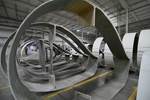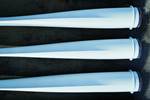UMaine researchers aim to recycle wind turbine blades as 3D printing material
With a DOE grant in hand, UMaine’s ASCC seeks to develop an approach to recycle shredded wind turbine blade material as a cost-effective reinforcement and filler for large-scale 3D printing.
A team of University of Maine (UMaine, Orono, U.S.) researchers have secured a $75,000 grant to explore recycling wind blades as feedstock for 3D printing. The award is a Phase 1 winner from the Department of Energy’s (DOE, Washington, D.C., U.S.) Wind Energy Technologies Office’s Wind Turbine Materials Recycling Prize.
Led by the university’s Advanced Structures and Composites Center (ASCC), the Wind Rewind team’s project “Blades for Large-Format Additive Manufacturing” marks a milestone in their mission to advance recycling solutions for a circular wind energy economy.
“We are grateful for the Department of Energy’s continued support in our mission to advance wind energy technologies,” says Habib Dagher, executive director of the ASCC. “With thousands of wind blades destined for landfill disposal, this funding allows us to explore the responsible recycling of these products, to reuse and repurpose them as feedstock materials for 3D printing.”
A follow-on phase would enable the development of larger prototypes and deployment of case studies with industry partners.
The project proposes an innovative approach to recycle shredded wind turbine blade material as a cost-effective reinforcement and filler for large-scale 3D printing. By substituting short carbon fibers with shredded and milled material from wind blades, the team aims to achieve mechanical recycling of 100% of the composite blade material.
Research efforts will focus on developing new compounding methods to achieve the necessary adhesive bond strength of the composite material. Resulting pellets will serve as feedstock for large-format extrusion-based 3D printing, leveraging the ASCC’s advanced manufacturing capabilities.
In addition to the sustainability benefits of the research, the project could benefit the global precast concrete industry, which is valued at billions of dollars annually. By integrating shredded wind turbine blade material into the 3D printing process for precast concrete formwork, the team aims to significantly reduce material costs while providing geometric freedom for design and automating manufacturing processes.
This project also addresses the critical need for sustainable recycling of wind turbine blades and presents economic advantages for the construction industry by lowering formwork costs and reducing labor expenses.
The project aligns with UMaine ASCC’s broader environmental goals, aiming to reduce the environmental footprint of land and offshore wind energy and developing environmentally friendly feedstock for large-scale 3D printing processes.
A follow-on phase would enable the development of larger prototypes and deployment of case studies with industry partners, ultimately driving wider adoption of sustainable practices in wind energy recycling.
The Wind Rewind team members leading this project submission include faculty and researchers from the ASCC, the Department of Civil and Environmental Engineering, the Department of Mechanical Engineering and industry (Dr. Roberto Lopez-Anido, Dr. Reed Miller, Dr. Amrit Verma, John Arimond, Dr. Habib Dagher, Hannah Berten, and Ed Pilpel). This project is led by Dr. Lopez-Anido with coordination support from Dr. Miller and Dr. Luis Zambrano-Cruzatty.
Related Content
-
Infinite Composites: Type V tanks for space, hydrogen, automotive and more
After a decade of proving its linerless, weight-saving composite tanks with NASA and more than 30 aerospace companies, this CryoSphere pioneer is scaling for growth in commercial space and sustainable transportation on Earth.
-
Plant tour: Teijin Carbon America Inc., Greenwood, S.C., U.S.
In 2018, Teijin broke ground on a facility that is reportedly the largest capacity carbon fiber line currently in existence. The line has been fully functional for nearly two years and has plenty of room for expansion.
-
TU Munich develops cuboidal conformable tanks using carbon fiber composites for increased hydrogen storage
Flat tank enabling standard platform for BEV and FCEV uses thermoplastic and thermoset composites, overwrapped skeleton design in pursuit of 25% more H2 storage.

















